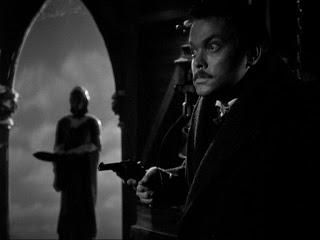
"Killing is what led you here. It won't help you now."
The Stranger (1946) gave Orson Welles his biggest hit, mating his signature style to a popular melodrama. It's an effective thriller made at a time when fascism's rebirth seemed a real possibility.Mr. Wilson (Edward G. Robinson) of the Allied War Crimes Commission hopes to ferret out Nazi war criminal Franz Kindler (Orson Welles). He releases Kindler's old colleague, Konrad Meinecke (Konstantin Shayne), to find him and discovers that Kindler is teaching at an American college under the name Charles Rankin. Wilson tries to enlist Rankin's wife, Mary Longstreet (Loretta Young) to bring him to justice. But Mary refuses to accept the truth until she herself becomes Rankin's target.
A smart and efficient work, The Stranger plays on postwar fears of Nazi resurgence. Kindler disappears into American society, marrying the daughter of a Supreme Court justice and teaching on an American campus. Perhaps the conceit is implausible, yet Welles knew of the US government collaborating with Nazi scientists and introducing ex-officials into the occupation government. Welles sees fascism infecting America from within a real possibility; his own liberal activism made him a target of the Hollywood blacklist and helped damage his career.
Supposedly, studio recuts neutered Welles and writer Anthony Vellier's more overt politics. Even so, the conceit's potency remains: Kindler daylights as a professor while destroying evidence of his crimes, killing dogs and people with inhuman abandon. Mary's affection shields him from suspicion until he lets his identity slip, justifying Germany's actions to Wilson while damning Karl Marx as a Jew. Wilson shows Mary films of concentration camps to break her resistance, a shocking sight to 1940s audiences. Kindler's antique clock tower provides a striking metaphor for nascent Nazism: it's also an amphitheater for the climax, with whirring figures drowning out screams and gunshots.
The Stranger's ragged narrative occasionally devolves into set pieces and long dialogues: there are too many scenes with a comic druggist (Billy House) who plays checkers and trades exposition with Wilson. Even so, Welles' direction more than redeems any shortcomings. Russell Metty's photography mixes expressive close-ups with chiaroscuro shadows and incredible depth of focus, illuminating whole rooms through mirrors and open windows. Welles uses dizzying long takes more immersive than Touch of Evil's showmanship; an overhead shot of Rankin and Meinecke strolling through the woods last nearly four minutes. The only bum note is Bronislaw Kaper's bombastic score.
Edward G. Robinson plays well to type as an unflappable investigator; having unveiled prewar Nazis in Confessions of a Nazi Spy, it's fitting that he foils Kindler's postwar plot. Loretta Young fares well in a difficult role that mostly involves reacting with shock and indignation. But Orson Welles dominates, a role far nastier than his Harry Lime. He's convincing as a psychopath gloating over his untouchability and cleverness, allowing a shade of humanity to creep into his relationship with Mary. It's one of Welles' more underrated performances, a slick and intimidating villain.
Films about ex-Nazis plotting restoration lingered for decades, long after the Fourth Reich ceased to be a possibility. As recently as two years ago, Captain America: The Winter Soldier exploited the subject for an easy villain. If The Stranger's dread predictions didn't come to pass, it's a potent reminder of the moral compromises faced by postwar America.

